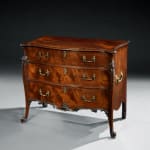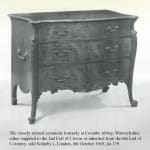A GEORGE III MAHOGANY COMMODE ATTRIBUTED TO JOHN COBB
Width: 42.25” / 107.3cm
Depth: 25” / 63.5cm
Further images
Provenance
The Collection of Lord and Lady Weinstock
Sold Christie’s, London, 22nd November 2022, Lot 89, GBP £94,500
Literature
Lucy Wood, The Lady Lever Art Gallery: Catalogue of Commodes (London, 1994), pp. 43-53
COMPARE
Only four other commodes of the same model as the present commode are known:
Example formerly in the collection of Mrs. Venetia Gairdner at Hingaston House, illus. Wood, Catalogue of Commodes (London, 1994), p. 53, fig. 39
Example formerly at Coombe Abbey, Warwickshire, sold Sotheby’s, London, 8th October 1965, lot 139
Example formerly with R. A. Lee sold Christie’s, New York, 19th April 2001, Lot 148, USD $446,000
Example in the Metropolitan Museum of Art, New York (Accession No. 64.101.1142)
Publications
A. Coleridge, ‘Sir Lawrence Dundas and Chippendale’, Apollo, September 1976
A very fine quality George III serpentine mahogany commode, the segmented crossbanded moulded shaped top above three long cockbeaded drawers, the keeled stiles moulded and carved with C-scrolls, acanthus and a tapering sting of husks and terminating in scrolled feet, the apron carved with fronds, C-scrolls and a central foliate clasp and continuing to side aprons and back legs of pelta-shaped profile, the whole mounted with the original elaborate foliate brass handles, escutcheons and carrying-handles
The present commode is part of a small group of closely-related commodes attributed to William Vile & John Cobb discussed by Lucy Wood in section one of her Catalogue of Commodes (London, 1994), pp. 43-53.
Within the wider group, the present commode is part of a smaller sub-set comprising examples of this model, of which only four others are known. These are (1) the example formerly in the collection of Mrs. Venetia Gairdner, (2) the example formerly at Coombe Abbey, Warwickshire, (3) the example formerly with R. A. Lee (sold Christie’s USD $446,000) and (4) the example in the Metropolitan Museum of Art, New York (Accession No. 64.101.1142).
The group of commodes discussed by Wood is anchored by the documented commode supplied by Cobb to James West for Alscot Park in 1766 for £16. The group includes other sub-sets including commodes with female term mounts and cloven hoof feet. The present commode and the sub-set of which it is part relate to these closely in terms of overall curvilinear form, apron carving and mounted ormolu handles, escutcheons and pelta-shaped profiles which are, in fact, represented on the documented commode.
The commode is conceived in the pittoresque manner or ‘French taste’, deriving from Louis XV models and the repertory of fluid rocaille ornament of the period. The fashion was popularised as well as anglicised by the draughtsmen and cabinet-makers of London, chief among whom was Thomas Chippendale whose editions of the Gentleman and Cabinet-Maker’s Director included designs for ‘French commodes’ or ‘French commode tables’ (LXIV-LXVI, LXVIII-LXIX) which were widely executed by other members of the trade.
The present commode closely follows Chippendale’s 1753 pattern for a ‘French commode table’, published in reverse as plate XLV in the 1754 and 1755 editions, renumbered as plate LXVI in the 1762 edition. The preparatory drawing for the plate survives in the Met (Accession No. 20.40.2(57)). Cobb, appointed cabinet-maker to George III with his partner William Vile, was renowned for commodes in the French taste. After the retirement of his partner in 1764, Cobb took on the running of the firm and it is likely that the present commode dates to these years.





